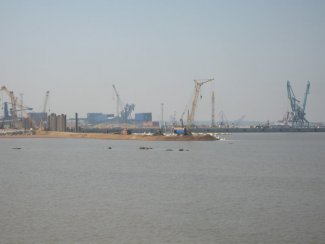Ukraine attacks the Russian port of Ust-Luga. Day 698 of the war


The situation on the front has not fundamentally changed. The Russians still hold the initiative, but their repeated assaults on several sections have brought them only minimal gains. The exception is Avdiivka, where they have captured a resistance point on the south-eastern outskirts of the town, which has been a target of attacks since the first days of the war. The Russian infantry is attempting to capitalise on this success and infiltrate the town proper. The invaders’ troops have so far advanced from between a few hundred metres to a maximum of 2–3 km in the area (starting from the 2014 demarcation line). At the same time, the Russians have made no progress in attacking the wings of the Ukrainian positions in the vicinity of the coke-chemical complex and the villages of Stepove and Sieverne.

On the night of 22–23 January, the invaders carried out further missile strikes. According to the Ukrainian Air Force Command, the Russians used 41 missiles, 21 of which were shot down. By using a combination of missiles of different types, they largely succeeded in breaking through the enemy’s missile defence systems. The cities of Kyiv and Kharkiv suffered the most damage; at least some civilians were killed in each. It is not known what the main targets of the attacks were.
Since 17 January, there has been a relatively low level of Russian air attack activity. The invaders used a total of 68 Shahed 131/136 drones in this period, of which the anti-aircraft defence claimed to have shot down 53. On several occasions it also used missiles launched from S-300 systems to strike targets located in Kharkiv and Donetsk oblasts.

Ukrainian drones have once again successfully attacked industrial facilities located deep inside Russia. The most spectacular strike took place on the night of 20–21 January, when a gas condensate processing plant in Ust-Luga in Leningrad oblast was hit, starting a huge fire. The facility belongs to Novatek, and its operation was suspended for an indefinite period. The attack brought significant financial losses to the company, whose owners are closely linked to the Kremlin, and in the long term could lead to major logistical problems. In addition to the Ust-Luga terminal, drones also attacked facilities in St Petersburg and in the Bryansk, Oryol, Smolensk and Tula oblasts in recent days; the strikes included an armaments plant in Tula and an oil storage depot in Klintsy. These strikes are indicative of the Ukrainian arms industry’s increasing capacity to produce drones, which are capable of effectively attacking poorly shielded industrial and infrastructure facilities some 1000 km away from their launch bases.
On 19 January, Ukrainian military intelligence revealed that the Blackjack hacking group, acting on its behalf, had carried out a cyber-attack on the Main Board of Construction of Special Facilities, which is subordinate to the Russian Federation’s ministry of defence. 1.2TB of data, including technical documentation concerning more than 500 military facilities, was extracted and deleted from the servers.
The Yermak-McFaul International Working Group on Sanctions against Russia published a report on 17 January entitled How to Identify and Exploit Kremlin Weaknesses in Computer Networks and Software. It points out that Russia’s military-industrial complex relies heavily on interconnected software systems running on Red Hat Linux.
Information has emerged on Russian social media confirming the effectiveness of last weeks Ukrainian attacks. On 14 January, at least 10 officers were said to have been killed in the downed A-50 aircraft and the severely damaged Il-22. Obituaries have also been published of officers who died in Ukrainian missile attacks on the Saki airfield from 5 to 6 January, a command post in Sevastopol on 4 January, and one of the Airborne Forces’ command posts on 19 September.

The formula for military support to Kyiv is being transformed. Instead of a broad group of states covering the entire spectrum of military assistance under the US-led Ramstein Group, coalitions of states have emerged who have agreed to strengthen specific military capabilities within the Ukrainian Armed Forces. So far, the ‘F-16 Coalition’ led by Denmark and the Netherlands, the ‘Maritime Capability Building Coalition’ led by the UK and Norway, and the ‘Air Defence Strengthening Coalition’ led by the US and UK have been formed. On 18 January, France announced the formation of an ‘Artillery Coalition’, whose aim is for willing countries to finance the manufacture of French CAESAR howitzers for the Ukrainian Armed Forces. Paris maintains that it is in a position to produce 78 such guns in 2024, six of which have already been purchased by Ukraine from its own resources. Another 12, at a cost of €50 million, will be financed by France, while the costs of manufacturing the remaining 60 are to be covered by other countries in the coalition. For the time being, there have been no official declarations regarding how or whether other countries will finance the production of CAESARs. It is also doubtful whether the year-round production of the Nexter factories will in fact be diverted to Ukraine. Furthermore, Paris has promised to supply Kyiv with 3000 155-mm artillery shells per month in 2024 – an amount equivalent to just 12–24 hours of current consumption. It further announced that it would supply Ukraine with a further 40 SCALP-EG cruise missiles.
On 22 January, Polish prime minister Donald Tusk paid a visit to Kyiv, during which he met President Volodymyr Zelensky and Prime Minister Denys Shmyhal, among others. Poland announced that it would join the G7’s July 2023 declaration on concluding bilateral commitments to provide long-term military and non-military assistance to Ukraine, and that it would continue work on creating Polish-Ukrainian joint ventures which can enhance both countries’ defence capabilities. Zelensky also announced that Warsaw had prepared a new package of military support for Kyiv.

The government is increasing its military spending. On 22 January, the defence ministry announced the allocation of an additional 657 million hryvnias (c. $17.5 million) from the budget reserve for the purchase of ammunition, thermal imaging cameras and drones, as well as funding for military intelligence. These funds will be distributed in proportion to the needs reported by each brigade on the frontline.
Employees of the defence industry will not be called up for military service. On 16 January, the Government lifted restrictions on the number of employees of enterprises in the defence-industrial complex who are exempt from military service. According to the decision, conscriptable employees of enterprises, institutions and organisations which the Ministry of Strategic Industry of Ukraine recognises as critically important to the complex will not be conscripted into the army.
The defenders are systematically expanding their strike-drone subdivisions. On 16 January, Lieutenant Robert Brovdi, a.k.a. ‘Magyar’, one of Ukraine’s best-known drone operators, announced the expansion of his subunit to battalion level. Henceforth, the 414th Separate Strike Drone Battalion is to operate as part of a Marine infantry grouping. Other units have also reported the expansion of similar subdivisions, including the 3rd Assault Brigade which is currently on rotation. This indicates that the Ukrainians have learnt from the failure of the 2023 summer offensive and have initiated systemic changes in the organisation of the army, taking into account the huge increase in the importance of drones and electronic warfare systems.

The deputy head of Ukrainian military intelligence, Vadym Skibitsky, admitted on 17 January that the mobilisation operations being observed in Russia are so effective that the adversary is successfully replenishing its losses on an ongoing basis. Referring to the Kremlin’s threats of aggression against the Baltic states, he said that the human and material reserves of the invaders are not sufficient to conduct strategic operations in two or three directions simultaneously.

On 21 January President Zelensky stated that for the time being he saw no need to mobilise an additional half a million men. He added that the military had not provided him with details of a plan to use such a large number of soldiers. He drew attention to the high financial costs of extensive general conscription, and announced that any such action should primarily be carried out to rotate the soldiers on the frontline.
An operation to combat smugglers of men evading military service is underway. On 16 January, the State Border Service of Ukraine in Lviv oblast uncovered an illegal procedure involving a certain transport company which concluded fictitious contracts with drivers and entered their data into the Shliah electronic system, which gives bearers the right to cross the border. Each contract cost €4000 per person.

The Russians are continuing to expand their defence lines and repression, as well as preparing for the presidential elections. In Mariupol, there are increasingly frequent reports of civilian vehicles being requisitioned and used to transport construction materials. More than 50,000 people have been brought into the city from regions of the Russian Federation and Central Asian countries to carry out fortification work. In addition, the presence of workers from Belarus has been confirmed in the partially occupied Kherson oblast.
On 17 January, the Russians organised a campaign in Luhansk oblast to collect signatures in support of Vladimir Putin’s candidacy in the March presidential election. Ukrainian military intelligence has indicated that the occupation administration wants to increase turnout by all possible means. To this end, it is planning to redeploy additional National Guard and special services forces to the occupied Ukrainian territories.





